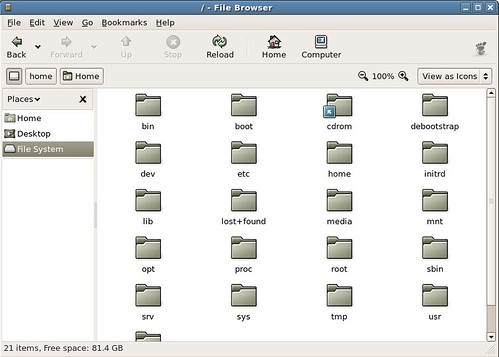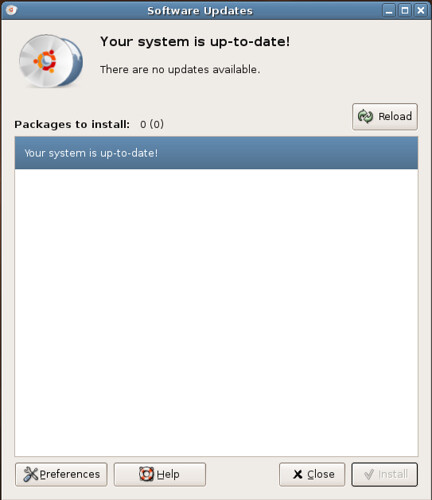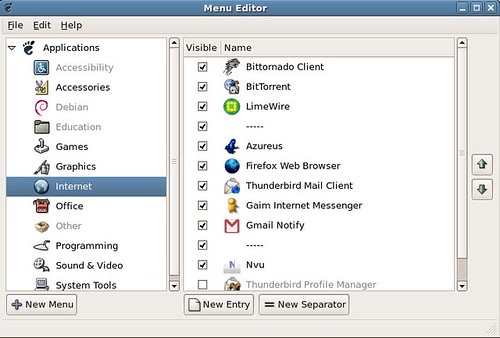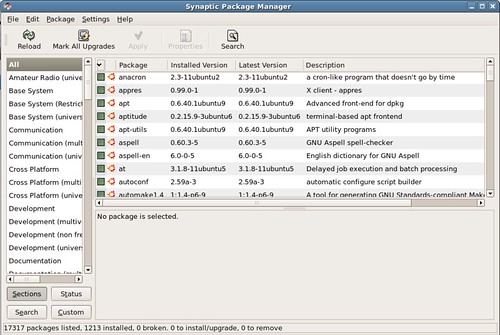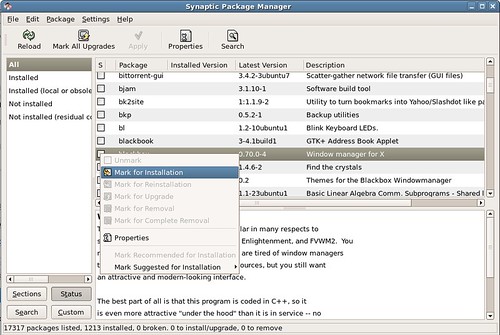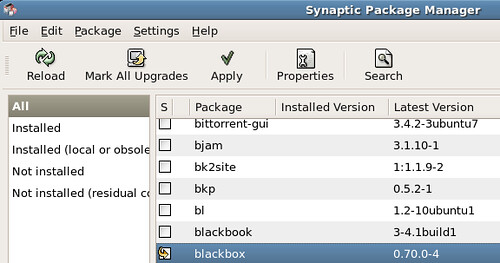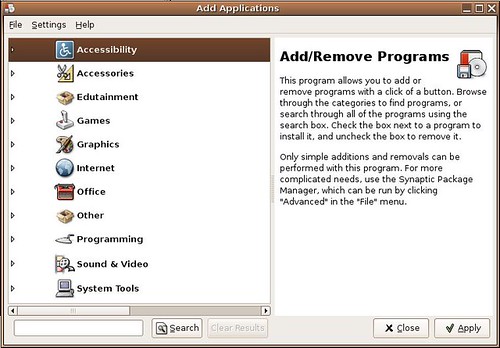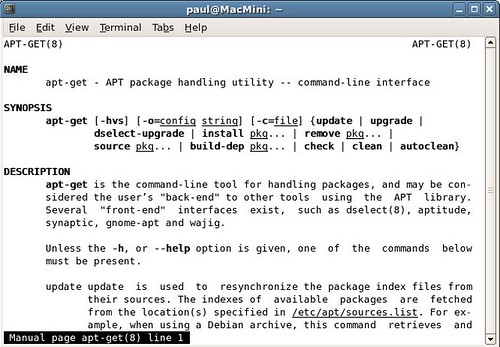HOW TO: Ubuntu Linux for Novices
 Ubuntu, a popular distribution of the Linux operating system, has acquired a wildly growing user base and today I have joined them. Described as being Linux for Human Beings, Ubuntu is somewhere in between Mandriva (formerly Mandrake) and Fedora Core in terms of ease of use. It is far from Gentoo (my personal favorite because of the emerge package manager), which should be pleasing to novice users that want a more versatile Linux installation. Ubuntu has recently been awarded Best Distribution.
Ubuntu, a popular distribution of the Linux operating system, has acquired a wildly growing user base and today I have joined them. Described as being Linux for Human Beings, Ubuntu is somewhere in between Mandriva (formerly Mandrake) and Fedora Core in terms of ease of use. It is far from Gentoo (my personal favorite because of the emerge package manager), which should be pleasing to novice users that want a more versatile Linux installation. Ubuntu has recently been awarded Best Distribution.
Downloading & Burning
The first thing you need to do is fire your browser over to ubuntu.com/download. Go to the bottom of that page and select a download mirror. I've always had good download rates with the Indiana mirror. There are three downloads under Install CD. Download the ISO file that you need for your system. If you are not sure which one you need, chances are it is going to be the first one for x86 computers, unless your computer is a Macintosh. For example, for my PPC Mac install I downloaded the ubuntu-5.10-install-powerpc.iso file. After you have completed downloading the ISO file, burn it to a CD as an image with your favorite burning utility.
Installation
I installed the latest version of Ubuntu, 5.10 aka Breezy Badger, on a 1.5Ghz (overclocked) G4 powered Mac Mini on the internal hard drive. I will maintain a dual boot system, albeit not one in the typical sense, with my OS X install running off of an external 300GB firewire drive. To get it to boot on a Mac, you need to hold down the "C" key upon boot. The install process went by quickly; I was on in Ubuntu in 30 minutes. However, there is no full-fledged GUI install like Mandriva or Suse. However, you almost never need to tell Ubuntu anything. The installation process is fairly automated. By default, Ubuntu installs a number of applications that you cannot deselect or add to them in the installation process. This can be bad for users with slow systems that just want the bare minimum. Although, that can all be changed once the operating system is installed. Programs can be added or removed as you wish. Other than that, installation was a breeze and nothing near as complex as a Gentoo install. Shoot me an email if you have any installation questions.
First Impressions
Ubuntu comes bundled with the Gnome window manager, which has two taskbars. The one on the top features the menus and the system tray icons while the bottom taskbar has the open windows, show desktop, trash, and a virtual workspace switcher. If you feel more comfortable with a windows style format, you should consider Kubuntu which features the KDE window manager.
The first thing I noticed was how clean the desktop was... it was empty! I am used to it being littered with links to the distribution's website or trivial shortcuts to "home." The user interface is simple and pleasing with a nice icons and cursors. Ubuntu is a powerful operating system, with the version 2 of OpenOffice.org, a BitTorrent client, Mozilla Firefox, and gAIM instant messenger, among others, preinstalled. Ubuntu is much faster than OS X on my computer in terms of booting and general system tasks. It has a lot less to load up and doesn't have to load any fancy graphics. I did not notice any lag in the menus or the file explorer, nautilus. I was impressed at how all of my hardware worked flawlessly. The only thing that did not work was Wi-Fi via the Apple Airport Extreme card but I already knew about that. Just for a test, I plugged in several USB devices and all were recognized and functioning. This is a major relief as I remember my Gentoo Linux days where I would have to enter some lines in the terminal to mount or unmount anything.
The absolute first thing you need to do after Ubuntu installs is a system update. The update process is painless. Everything is done by the Update Manager, which you can find by going to System>Administration>Update Manager. A window should pop-up asking for the user password, this is normal. The update process is reasonably self-explanatory; select the packages and apply them by clicking Install.
After messing around with Ubuntu enough, there will come a time when you will need root privileges to complete certain tasks in the terminal. This was the case with me, so I opened up a terminal and attempted to do su, but Ubuntu wasn't having any of it. After some frustration, I set off to find a solution and sure enough Google told me that Ubuntu disables the root account by default. Instead, users must prepend sudo to any administrative task they wish to do.
Installing an Application
The first thing I wanted to do was install my favorite Linux BitTorrent client, Azureus. I searched for it in the Add Application program, but it could not be found in any repository. That means we must find the file off of Sourceforge and install it manually. Go to the download page and download the latest version of Azureus for your linux box. Again, since I am using a G4 powered machine I chose the PPC download. If you are running Ubuntu on an x86 machine, you will likely want the Linux GTK download. Now thankfully Ubuntu already has Java installed which saves a lot of time in installing that. Java installations in Linux are usually fairly advanced as you have to go around and give config files the path to Java. Now that you have an Azureus file on your desktop with a .tar.bz2 extension, we are ready to begin the installation. Open up a terminal; this can be found at Applications>Accessories>Terminal. Type the following lines exactly and your installation should be done quickly.
cd Desktop/
tar xjf Azureus_2.3.0.4_linux.PPC.tar.bz2
sudo mv azureus/ /usr/lib/
cd /usr/lib/azureus
./azureus
Note: Type in the actual name of your Azureus download in the second command. You can also type ls to display your Desktop's contents or type Azureus and hit tab for tab completion.
The ./ runs Azureus. This part must work and open up Azureus for us to continue. If it does not go back and make sure you have downloaded and installed the correct Azureus for your system. Now we need to add a shortcut to Azureus in the Applications menu. This makes it a lot easier to access Azureus. Go to Applications>System Tools>Applications Menu Editor and click Internet on the left pane. Click on the New Entry button and fill out the fields.
Name: Azureus
Comment: Azureus BitTorrent Client
Command: /usr/lib/azureus/azureus
Icon: Click on "No Icon" and in the file browser that pops up navigate to /usr/lib/azureus and select Azureus.png
Before you click OK everything should look like this. If so, you can now close the Menu Editor. You can now access Azureus going to Applications>Internet>Azureus.
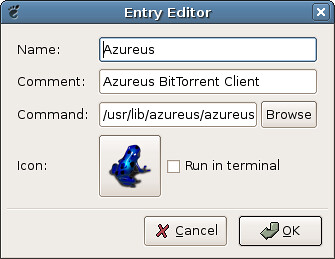
If Azureus or any other Java based application isn't running as expected you will probably want to update to a more recent version of Java such as 1.5. To do that download JRE 5 update 5, keeping in mind this is not for PPC users, and do the following:
sudo apt-get install fakeroot java-package java-common
fakeroot make-jpkg jre-1_5_0_05-linux-i586.bin
sudo dpkg -i sun-j2re1.5_1.5.0+update05_i386.deb
sudo update-alternatives --config java
java -version
To update your Java installation in a PPC based Ubuntu install, please visit this thread over at UbuntuForums.org.
This is the typical method for installing simple applications in Ubuntu, or most other Linux distributions for that matter. However, other distributions with different window managers have unique ways of putting links to applications. For example, in the Blackbox/Fluxbox window manager you must edit a file to include an entry to that application in the right click menu. If you have ever seen the typical method for installing applications on a more complex distribution of Linux you will notice how many things are compiled from source. While compiling from source builds the application around your computer's individual settings and makes it run more efficiently, it is often too difficult or time consuming for the beginning Linux user. Therefore Ubuntu does not come with a preinstalled compiler such as gcc. If you ever want to gain that functionality you need to execute sudo apt-get install gcc in the terminal. After you do this, if you want to install an application from source usually you extract the file to a folder (tar xjf for .tar.bz2 and tar xzf for .tar.gz) and then run the following commands:
cd /path/to/folder
./configure
make
make install
An Easier Way to Install Programs
Ubuntu has a great package manager called Synaptic that lets you search for or find applications to install or remove from a list. You can check it out by going to System>Administration>Synaptic Package Manager. You can easily sort packages by category, their installation status, or by searching. If you find a package you want to add click it and select Mark for Installation. Once you've selected all the packages you wish to install, remove or upgrade at this time, click the Apply button. It's as easy as that. However, not every application will be on this list and betas are usually never listed. In those cases you must go out and download the installer elsewhere and install it manually. Such is the case if you want the latest version of Firefox the day it comes out. It might take the repositories a day or two to get the latest versions.
There is also a simpler version of the Synaptic Package Manger aptly-named Add Applications. You can access that via Applications>Add Applications.
Making Ubuntu More User Friendly
My main gripe with many Linux distributions is the lack of the normal web fonts such as Verdana, Tahoma, etc. This explains why many websites appear differently than how you are used to viewing them. Don't worry there's an easy fix I found on UbuntuGuide.org. Open up a terminal and follow along.
sudo apt-get install gsfonts-x11
sudo apt-get install msttcorefonts
sudo fc-cache -f -v
sudo cp /etc/fonts/local.conf /etc/fonts/local.conf_backup
sudo gedit /etc/fonts/local.conf
Paste the text found here in gedit and save. You might have to restart your browser or gnome until the new fonts are used.
Should I Even Bother?
I think it is worth your time to check out Ubuntu if you will be installing it on an x86 or AMD64 computer. However, I recommend staying away from Ubuntu for PowerPC computers. My PPC Ubuntu install has given me mixed results. Most things run spectacular but many applications that I wish to install are not offered in PPC flavors. For example, Azureus runs best with Java 1.5 but Sun Microsystems does not make it for PPC so I've had to resort to similar Java packages by IBM and BlackDown, which are a pain to install and buggy at best. And then there is the aforementioned problem with the lack of a decent flash player since Macromedia refuses to support Linux PPC platforms. If you are interested there is a workaround via sudo apt-get install swf-player but it only works half the time and is a CPU hog. RealPlayer is another application that lacks PPC support. For the other 99% of prospective users (not running PPC), Ubuntu is an amazing OS. It's targeted for ease of use and is one of the few Linux distributions I have touched that can be described as "It just works."
Things You Should Know
- The Terminal is your friend. It will scratch your back for you. I suggest putting a launcher to it on the taskbar by right clicking Terminal in Applications>Accessories>Terminal and selecting Add this launcher to panel.
- Most applications in Ubuntu are stored within /usr/lib/ (the equivalent of C:\Program Files).
- Linux can only handle one sound stream if your sound driver is not fully supported by ALSA, which I find to be quite often. If you watch a movie and then close the movie player, it is normal for a slew of gAIM sounds to play for a while as that sound stream was cached for later playback. If you are streaming internet radio in Amarok and then open a video in VLC, the sound from Amarok will be heard.
- If a program ever seizes up, you can force quit it using the killall [program] command. You can view active processes and kill them if necessary via top. Typing k and then the PID of the process you can kill that process. This isn't always the case, so you many need to do killall -9 [command].
- The man command can be used before any command you wish to learn about. For example, man apt-get will list the man pages. To exit the man pages and go back to the terminal press q.
- You can manage system packages via the apt-get command. Here are a few to keep handy...
sudo apt-get update sudo apt-get upgrade sudo apt-get install [package name] sudo apt-get remove [package name]You can search for packages to install via packages.ubuntu.com.
- pwd tells you what directory you are in (print working directory), cd changes the directory, cd .. goes back up (out) a directory, ls lists the contents of a directory, nano is a simple text editor while more and less are simple text viewers, unzip unzips zip archives, tar is a valuable decompression tool, ./ executes some files (eg., *.sh files), other programs can be accessed by typing their name such as firefox.
- Here are some more important commands.
- If you need to switch between Java installations use
sudo update-alternatives --config java
Ubuntu Resources
Here are some great resources that can answer any of your Ubuntu questions. I know I could not have written this article without consulting them several times.
